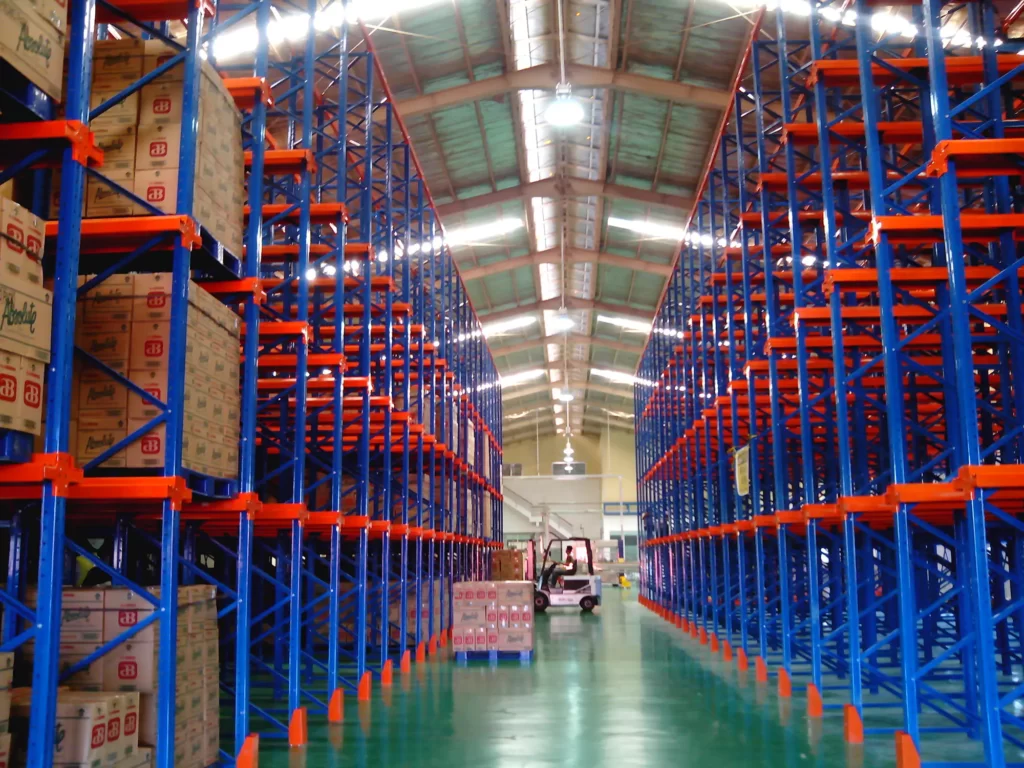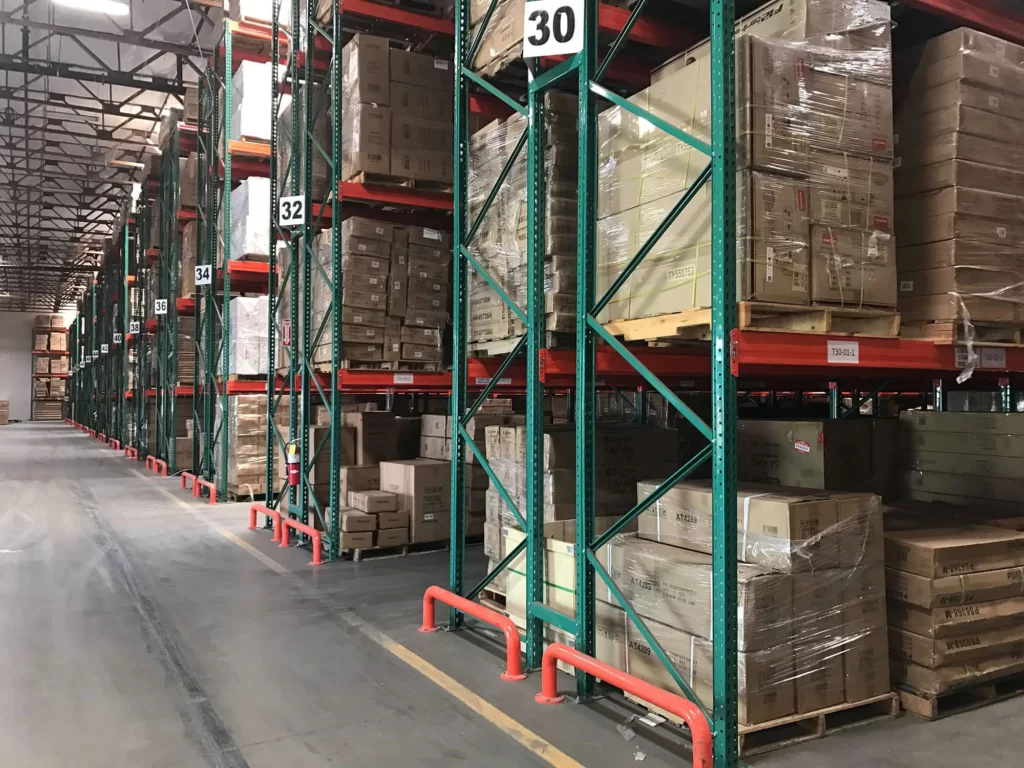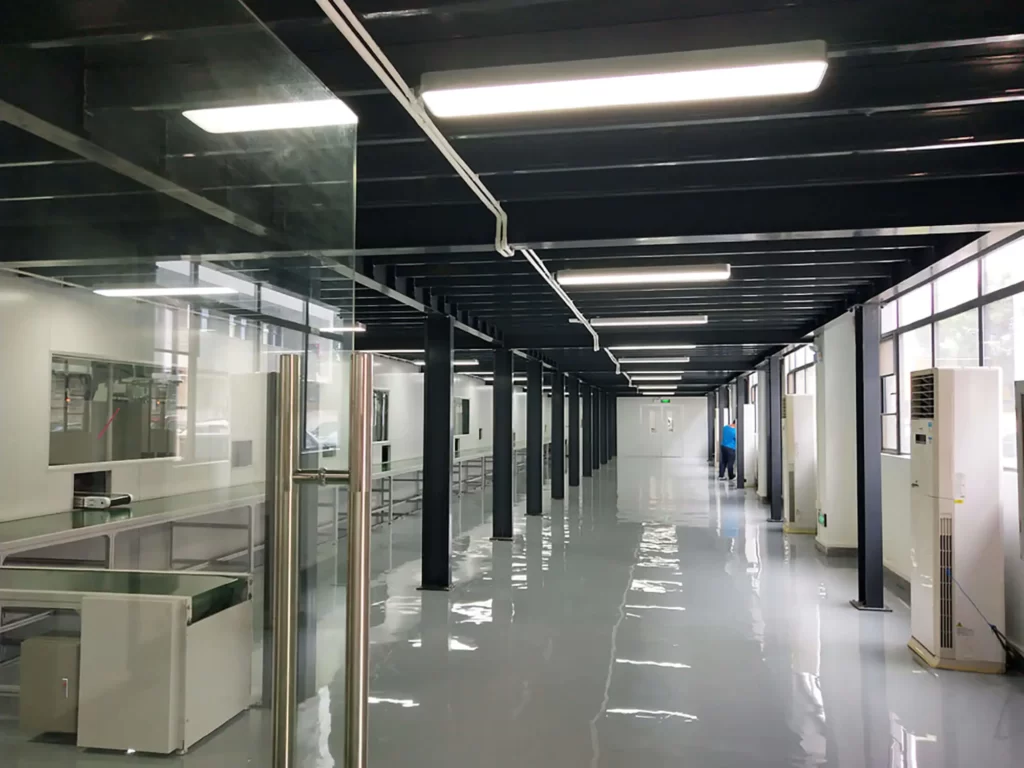In recent years, with the rapid development of China’s logistics industry, automation and information technology to improve the degree of integration of logistics information technology and automation technology of various types of intelligent logistics equipment rapid development, automated warehouse system is a representative of the equipment. As a modern warehouse staff to master some of the common knowledge of automated warehouses to enhance their own professionalism to help enterprises reduce costs in storage costs.

First, the definition of an automated warehouse system
An automated warehouse system is a new concept in logistics and warehousing. The use of warehouse system equipment can realize the rationalization of the upper levels of the warehouse, access automation, and operation simplicity; an automated warehouse system is the current higher level of technology form. The main body of the automated warehouse system is by the racks, aisle-type stacking cranes, into (out of) the warehouse workbench, and automatic transport into (out of) and operation control system. racks are steel or reinforced concrete structures of the building or structure, racks are standard size cargo space, aisle stacking cranes through the aisle between the racks to complete the work of storage and retrieval of goods. Management using computer and bar code technology.
Second, the advantages and disadvantages of an automated warehouse system
Advantages:
1. Improve space utilization: the full use of the vertical space of the warehouse, the storage capacity per unit area is much larger than the traditional warehouse. In addition, the traditional warehouse must be categorized items stored, resulting in a large amount of unused space, automated warehouse system can be stored randomly, any goods stored in an empty warehouse, the system automatically records the exact location, greatly improving the utilization of space.
2. To achieve the material first in first out: traditional warehouse due to space constraints, the material will be stacked yard, often first in and then out, resulting in material backlog waste. An automated warehouse system can automatically bind the time of each vote of materials into the warehouse and automatically realize the material first in first out.
3. Intelligent operation account synchronization: traditional warehouse management involves a large number of documents passed, and many by manual entry, the process is redundant and prone to error. Cube warehouse management system and ERP system docking, from the development of the production plan to the issuance of goods in and out of the warehouse instructions, the whole process can be automated operations, and the system automatically over the accounts, to ensure that the information is accurate and timely, to avoid the problem of the accounts are not synchronized.
4. Meet the requirements of the goods to the environment: compared with the traditional warehouse, can better meet the needs of the special storage environment, such as light, low temperature, toxicity, and other special environments. Ensure the safe operation of goods in the whole storage process, and improve operational efficiency.
5. Traceable: through bar code technology, etc., accurate tracking of the flow of goods to achieve traceability of goods.
6. Save human resources costs: stereo warehouse, all kinds of automated equipment instead of a large number of manual operations, greatly reducing human resources costs.
7. Timely processing of inventory material: part of the material due to product obsolescence into inventory material, forget to book into the dead material, can not be cleaned up on time, both occupy inventory space, but also occupy funds. The automated warehouse system of material entry, automatic bookkeeping, does not produce dead material, can search for a certain period of time no operation of the material, and timely processing of inventory material.

Disadvantages:
1. Complex structure, supporting equipment, infrastructure and equipment investment is large.
2. Construction is more difficult and the construction period is long.
3. Strict requirements for the packaging of goods.
4. It is difficult to update and transform the system after completion.
5. The variety of stored goods is limited.
Third, the function of the automated warehouse system
1. Receiving: the warehouse from the supplier or production plant to receive a variety of materials, semi-finished or finished products, for production or processing and assembly.
2. Inventory: the unloaded goods stored at the location specified in the automated system.
3. Fetching: Get the goods required by the customer from the warehouse according to the demand, usually in a first-in-first-out (FIFO) manner.
4. Shipping: The goods taken out are sent to customers according to strict requirements.
5. Information query: can query the relevant information of the warehouse at any time, including inventory information, operational information and other information.
Fourth, automated warehouse system classification
According to the professional summary, the current automated warehouse storage system classification methods are mainly as follows.
(A) According to the height of the rack classification
1. Low-level warehouse storage system: low-level automated warehouse system construction height of 5 meters or less, generally through the old warehouse for reconstruction.
2. Medium-level warehouse system: the construction height of the middle-level automated warehouse system is between 5 meters and 15 meters, this warehouse does not have very high requirements for storage equipment, and the cost is reasonable, and favored by many users.
3. High-rise stereo warehouse: the height of the high-rise can reach more than 15 meters, the storage machinery and equipment requirements are high, and the construction is still more difficult.
(B) According to the rack structure classification
1. Cargo format warehouse storage system: cargo format automated warehouse system is widely used, the main feature is that each layer of racks is combined from the same size of the cargo compartment, the opening is facing the rack channel, and easy to drive the stacker truck and access to goods.
2. Through the warehouse storage system: through the automated warehouse system, is no interval between the storage racks, no channel, the entire rack combination is a whole. racks are longitudinal through, there is a certain slope, each layer of racks are installed with a chute, to allow goods to move along the chute from a high level.
3. Automated cabinet type warehouse system: the automated library is mainly suitable for small storage scale, can be moved, characterized by a strong close, intelligence, confidentiality.
4. Strip racks automated warehouse system: strip form warehouse is mainly dedicated to the storage of strip-shaped goods.
(C) According to the building form classification
1. Integral automated warehouse system: integral warehouse storage system is also called an integrated automated warehouse system, high-rise racks and buildings are built like one, and can not be separated so the permanent storage facilities use reinforced concrete construction, making the high-rise racks also have the stability.
2. Separate automated warehouse system: the separated warehouse is the opposite of the whole, the racks are built separately, and are separated from the building.

(D) According to the automated warehouse system in the form of goods access classification
1. Picking rack type: picking rack type in the picking mechanism is its core part, divided into two ways of in-aisle picking and out-of-aisle picking. The “picking before the person arrives at the goods” is the picking personnel takes the picking stacker crane to the goods grid before picking the required quantity of goods from the goods grid out of the warehouse. The “man-to-man picking” is where the pallets or containers with the required goods are picked from the stacker crane to the picking area, and the picking personnel pick the required goods according to the requirements of the bill of lading and then return the remaining goods to their original location.
2. Unit rack type: Unit rack type is a common form of the warehouse. The goods are first placed in pallets or containers and then loaded into the unit racks on the cargo space.
3. Mobile rack type: Mobile rack type consists of an electric rack, the rack can travel on the track, and the control device controls the rack to close and separate. When operating, the racks are separated and can be operated in the aisle; when not operating, the racks can be closed together, leaving only one operating aisle, thus improving the utilization of space.
(E) According to the degree of automation classification
1. Semi-automated warehouse system: semi-automated warehouse system refers to the access and withdrawal of goods part of the process is completed by the manual operation of machinery, and part is completed by the automatic control.
2. Automated warehouse system: automated warehouse system refers to the access and handling of goods that are automatically controlled to complete the process.
(F) According to the role of the warehouse in the logistics system classification
1. Production warehouse: production warehouse refers to the factory to coordinate the process and process, workshop and workshop, outsourcing and self-made parts between the logistics of the unstable and the establishment of the warehouse, it can ensure that the production process between the rhythm of production.
2. Circulation warehouse: circulation warehouse is a service warehouse, it is the enterprise to regulates the balance of supply and demand between the production plant and the user and the establishment of the warehouse. This kind of warehouse in and out of the goods more frequently, throughput is larger, and generally has direct contact with the sales department.
(G) According to the degree of automation warehouse and production of close contact classification
1. Independent warehouse: the independent warehouse is also known as an “off-line” warehouse, which refers to the operation of the flow of pinch and economic aspects that are relatively independent of the automated warehouse. This warehouse is generally larger, in storage capacity, and the warehouse system has its computer management, monitoring, scheduling, and control 06 system. Can also be divided into storage types and in the transformation of the warehouse. Such distribution centers belong to this type of warehouse.
2. Semi-close warehouse: semi-close warehouse means that its operational processes, warehouse management, access to goods and economic interests, and other plants (or internal, or parent units) have a certain relationship, but are not directly linked to other production systems.
3. Close warehouse: the close warehouse is also known as “online” warehouse, refers to those with other departments in the factory or production system directly linked to the automated warehouse, the relationship between the two more closely.
(H) In accordance with the functional classification of storage
1. Stereoscopic warehouse: storage stereoscopic warehouse is the main storage function, using high dense racks. Less variety of goods, large quantities, and long storage period.
2. Picking-type automated warehouse system: picking-type automated warehouse system mainly picks, more types of goods, and the number of shipments is small.

Fifth, the composition of the automated warehouse system
1. High-level racks: through the three-dimensional racks to achieve the goods storage function, make full use of three-dimensional space, and play a role in supporting the stacker crane. According to the different goods carrying units, three-dimensional racks are divided into pallet racking systems and turnover box racking systems.
2. Aisle stacker: aisle stacker is the core lifting and transportation equipment of the automated warehouse system, running along the track in the aisle of the high-rise racks to achieve the function of taking and sending goods. Lane stacker crane is mainly divided into single column stacker crane and double column stacker crane.
3. In and out conveying system: The aisle stacker can only operate inside the aisle, while the in and out of the goods storage unit outside the aisle needs to be completed by the in and out conveying system. Common conveying systems include conveyor belts, shuttle cars (RGV), automatic guided vehicles (AGV), forklifts, depalletizing robots, etc. The conveying system is docked with the aisle-type stacker crane to complete the handling and transportation of goods with the stacker crane.
4. Peripheral equipment: peripheral auxiliary equipment including automatic identification system, automatic sorting equipment, etc., whose role is to expand the functions of the automated warehouse system, such as can be extended to classification, measurement, packaging, sorting and other functions.
5. Automatic control system: the automatic control system is the entire automated warehouse system equipment implementation of the control core, upward connection to the logistics scheduling system, accept the material delivery instructions; downward connection to the conveyor equipment to achieve the drive of the underlying conveyor equipment, the detection and identification of the transported material; complete material delivery and process control information transfer.
6. Warehouse management system: the analysis and management of orders, demand, inbound and outbound, cargo space, unqualified products, inventory status and other types of warehouse management information.

Six, the design of an automated warehouse system
Stereo warehouse design steps are generally divided into the following steps.
(A) Collect, and study the user’s original information, to clarify the user to achieve the goal, this original information includes.
1. Clear automated warehouse system and upstream, and downstream articulation of the process.
2. Logistics requirements: upstream into the warehouse’s maximum incoming warehousemen, the maximum amount of downstream transit out of the warehouse and the required warehouse capacity.
3. The parameters of the material specifications: the number of varieties of materials, material packaging forms, outer packaging size, weight, preservation and other characteristics of other materials.
4. The site conditions and environmental requirements of the warehouse storage system.
5. The user’s functional requirements for the warehouse management system.
6. Other relevant information and special requirements.
(B) Determine the main form of automated warehouse system and related parameters
After all the original information is collected, this first-hand information can be calculated when the design of the relevant parameters is required, including.
1. The total amount of access requirements for the entire warehouse area, that is, the flow requirements of the warehouse.
2. The external dimensions of the goods unit and its weight.
3. The warehouse storage area (rack area) the number of bins.
4. Combined with the above three points to determine the storage area (rack factory) racks, the number of rows, columns and aisles number of other relevant technical parameters.
(C) Reasonable layout of the overall layout of the automated warehouse system and logistics map
Generally speaking, the automated warehouse system includes inbound staging area, inspection area, palletizing area, storage area, outbound staging area, pallet staging area, unqualified goods staging area and miscellaneous areas. Planning, an warehouse storage system does not necessarily have to be planned into each of the above areas, according to the user’s process characteristics and requirements to reasonably divide the areas and increase or decrease the area. At the same time, but also reasonable consideration of the flow of materials, so that the flow of materials is unimpeded, which will directly affect the capacity and efficiency of the automated warehouse system.

(D) The choice of machinery and equipment types and related parameters
1. Racks.
The rack design is an important element of warehouse system design, which directly affects the utilization rate of the automated warehouse system area and space.
① rack form: there are many forms of racks, and racks used in the automated warehouse system are generally: beam racks, cattle leg racks, flow racks, etc… The design can be reasonably selected according to the dimensions, weight and other relevant factors of the cargo unit.
② Size of the cargo compartment: the size of the cargo compartment depends on the size of the gap between the cargo unit and the rack column, crossbeam (bull leg), the same pair, to a certain extent, is also affected by the rack structure type and other factors.
2. Stacker crane.
Stacker is the core equipment of the entire automated warehouse system, through manual operation, semi-automatic operation or fully automatic operation to achieve the goods from one place to another. It is composed of frame (upper beam, lower beam, column), horizontal walking mechanism, lifting mechanism, loading platform, forks and electrical control system.
① Determination of stacker form: there are various forms of stacker, including single-track aisle stacker, double-track aisle stacker, turn-aisle stacker, single-column stacker, double-column stacker, etc.
② Determination of stacker speed: According to the flow requirements of the warehouse, the horizontal speed, lifting speed and fork speed of the stacker are calculated.
③ Other parameters and configuration: according to the warehouse site situation and user’s requirements, the positioning mode and communication mode of the stacker crane are selected. The configuration of the stacker crane can be high or low, depending on the specific situation.
3. Conveyor system.
According to the logistics map, the type of conveyor is selected reasonably, including roller conveyor, chain conveyor, belt conveyor, lifting and shifting machine, elevator, etc. At the same time, also according to the instantaneous flow of the warehouse to reasonably determine the speed of the conveyor system.
4. Other equipment.
According to the warehouse process and some special requirements of the user, some auxiliary equipment can be added appropriately, including hand-held terminals, forklifts, balance cranes, etc.

(E) Design WCS control system and WMS warehouse management system of each functional module
According to the warehouse process and the user’s requirements, reasonable design control system and warehouse management system. Control systems and warehouse management systems generally adopt modular designs, easy to upgrade and maintain.
(F) Simulation of the whole system
In the case of conditions, the whole system for simulation, can be a more intuitive description of the storage and transportation work of the warehouse, to find some of the problems and deficiencies, and make the corresponding corrections to optimize the entire AS/RS system.
(G) For the detailed design of equipment and control management system
The above-mentioned for the general process of automated warehouse design, in the specific design, can be combined with the specific circumstances of the flexible use.








